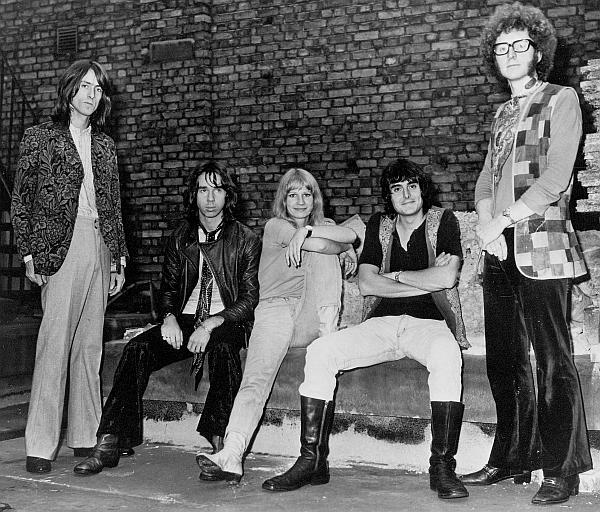- Affinity (band)
Infobox musical artist
Name = Affinity

Img_capt = Affinity
L-R: Grant Serpell, Mike Jopp, Linda Hoyle
Lynton Naiff,Mo Foster
Landscape = yes
Background = group_or_band
Origin =University of Sussex ,Brighton ,England
Genre =Jazz-Rock
Years_active = 1968—1971
Label =Vertigo Records ,Angel Air
Associated_acts = Ice
Russell's Clump
Sailor
RMS
Past_members = Lynton NaiffGrant Serpell Mo Foster
Mike Jopp
Linda HoyleAffinity were an English
Jazz-Rock fusion band, active from mid-1968 to January 1971.Origins
The origin of Affinity was, circa 1965, in the science department of the
University of Sussex inBrighton ,England . Three science students calledLynton Naiff (piano ),Grant Serpell (drums}, andNick Nicholas (double bass ) had formed the US Jazz Trio, they played at University events and local gigs. When Serpell graduated a year later he was replaced byMo Foster who had earlier been playingbass guitar in his school band but had now adapted to playing drums.After university Naiff and Serpell, along with members of other bands gathered from other university bands, formed the pop group Ice. Although Ice was moderately successful commercially it only lasted for about a year before it disbanded.
Although Ice had disbanded, Naiff and Serpell were keen to continue with a career in music. They decided to start a new jazz-influenced pop band. To this end they invited Foster to join them, only this time on bass guitar as Serpell would be carrying out the drummer's duties. After holding auditions they met ex-Tridents guitarist
Mike Jopp . They liked his playing and his ability to play both jazz and pop, and perhaps more importantly he had his own amp and a car.The auditions continued as they needed a singer. They unanimously decided on an English teacher they had met previously. Her name was
Linda Hoyle .After obtaining a loan, which was guaranteed by Jopp's father, they bought the equipment needed to start the band. They bought Impact amplifiers, a Hammond M102 organ, a Gibson EBO bass guitar, some microphones and a grey
Ford Transit van. They then spent the summer of 1968 rehearsing, writing, and generally chilling out at a rented bungalow on the edge of Brighton. The first thing they needed to do though was invent a name for themselves, eventually they settled on "Affinity" which came from the name of anOscar Peterson LP.Critical success
With the end of the 1960s a new music genre, "Jazz-Rock", was evolving and becoming popular. This genre suited the newly formed Affinity partly because they all came from a jazz background and partly because it was a way for them to show some individuality and a degree of separation from the other newly formed bands who were playing the equally popular blues-based rock.
Affinity played their first London show at the Revolution Club in
Bruton Place which is just offBerkeley Square inLondon . The date was 5 October 1968.One of the gigs they were playing at the time was broadcast on BBC Radio Jazz Club. jazz luminary,
Ronnie Scott , heard a recording of the show and subsequently agreed to manage them. He also agreed to give them regular bookings at his world-famous jazz club. This delighted the band as it would give them a stepping stone to further fame, and although it didn't pay that well they did "get to see incredible jazz artists every night — for free!"From this point on they were getting lots of live work in London's
discotheque and club scene and on the college circuit. They also succeeded in gettingEurope an andScandinavia n tours — which apparently didn't pay very well — and some festivals. They even managed to get some hard to come by TV spots, including "Disco 2" which was the forerunner to "The Old Grey Whistle Test ". They even managed an additional claim to fame, during some session work making jingles, of recording the theme for a famousShredded Wheat commercial series ("There are 2 men in my life..."). They released a critically-acclaimed eponymously titled album on the Vertigo label in 1970.They now considered themselves to be successful and as such treated themselves to the "ultimate instrument", a 'split' Hammond B3 organ. They couldn't yet afford a new one but they managed to purchase a second-hand one that had once belonged to
Brian Auger .The end
They received many rave reviews, most for the band, but some for individual members, including British
DJ Anne Nightingale's proclamation that Linda Hoyle was "the girl most likely to succeed in 1970". Perhaps this was a portent to the end. After two and a half years of playing, and not actually getting a lot of money for it the members were starting to realise that the fun had gone. In spite of a forthcoming US tour and Naiff and Foster starting to write a second album, Hoyle announced in the middle of a Swedish tour that she'd had enough and wanted to quit both the band and the music business.The band finished the remaining contracted gigs and went their separate ways.
Discography
Although Affinity only actually ever recorded one album at the time they existed, in recent years archived tapes have been discovered which enabled a further four Affinity-related albums to be 'posthumously' released.
*"Affinity" — (1970, Vertigo), (2002,
Angel Air )
*"Live Instrumentals 1969" — (2003, Angel Air)
*"1971-1972" — (2003, Angel Air)
*"Origins 1965-67" — (2004, Angel Air)
*"Origins: The Baskervilles 1965" (2007, Angel Air)In 2006 a 5-CD limited issue, collectors edition of the Affinity collection was released on the Japanese AMR "Archive" label. it was in a special packaging consisting of a reproduction of the original LP cover, with an expansive write up on the history of Affinity including a
Pete Frame -type family tree diagram designed by Mo Foster and Kurt Adkins.Related links
* [http://www.angelair.co.uk Angel Air website]
* [http://www.mofoster.com Mo Foster official website]
* [http://www.airmailrecordings.com AMR official website] (in Japanese)
Wikimedia Foundation. 2010.
